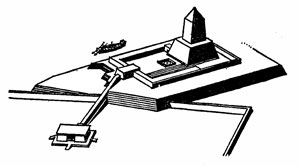The Locality and its Gods(Intro) Chambers: Subterranean chamber - earth Queen's chamber - water King's chamber - air Sun's chamber - fire Starry sky's chamber - aether Speculations: For the King or for the Priests? Grand Gallery - fire on earth To Gallery or water's chamber? Interesting Ante-chamber Earlier pyramids |
In 5th and 6th dynasty a new phaenomenon occurs: instead of one big pyramid the kings appearently prefer to build not only a pyramid not quite so big as in the 4th dynasty, but at the same time a similar sized sun temple. Some claim this period to be the peak of the Sun worship, but it might as well be a solution to a conflict between the King's interests and the priesthood's. The pyramid did not just grant the King's glorious afterlife, it also may have functioned as temple involving rituals, the performance of which gave the priesthoods their importance. Supposing some rituals were designed to take place inside the pyramid - the holyness of the pyramids can be compared with churches - there would be an inevitable conflict of interests. Should the priesthood be allowed to perform rites in and have access to the deseased king's pyramid, or should it be sealed to grant the king indisturbanned rest? |
